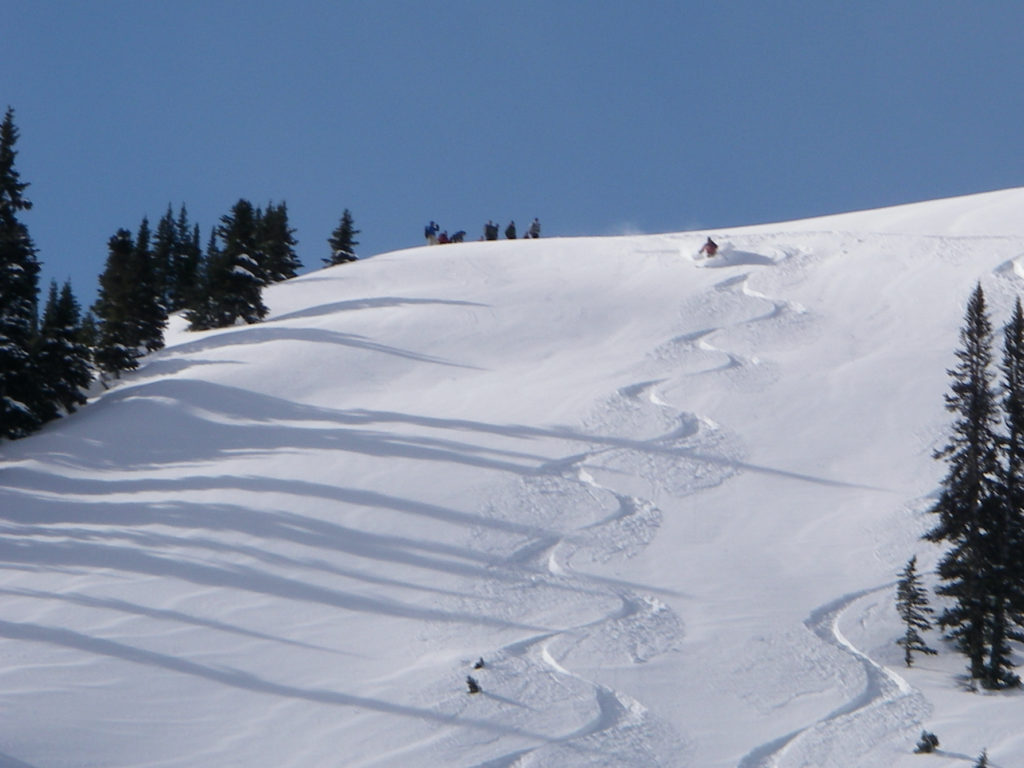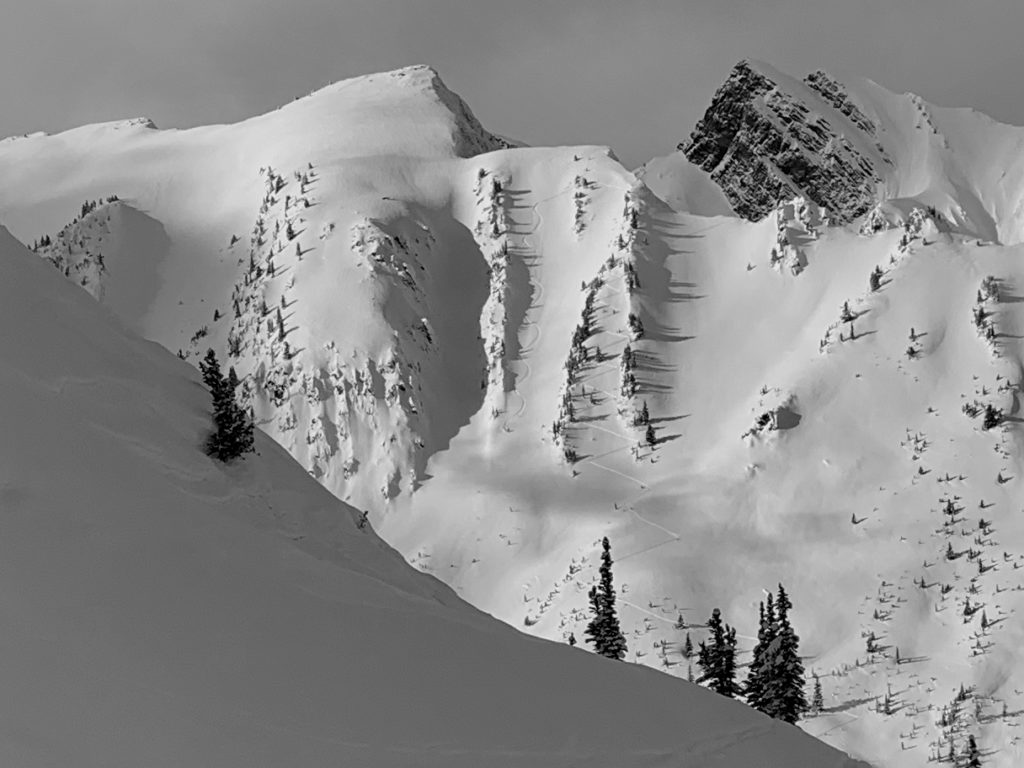Terrain Tip No. 5: Tactical Team Travel
We suggested in Terrain Tip No. 4 that knowing where not to go could be the most important terrain decision we make before heading into the backcountry. This primary tactic is accomplished by reading the backcountry avalanche forecast, communicating with local experts, identifying the location of the current problem, and agreeing on the terrain we want to avoid.
The problem is that despite the critical importance of identifying and locating the avalanche hazard in the terrain, we are human, we make mistakes, and we are comfortable thinking we know more than we do. Therefore our conversation about where we go has to be accompanied by a tactical team discussion detailing how to manage ourselves in the terrain in a way that further reduces the risk. Backcountry travel has to translate into a well-practiced method of safely moving our team through the mountains. The following tips do not outline formal terrain-travel protocols but share a strategy that has helped me make better travel decisions in avalanche terrain.

Skiers scope and photograph nearby terrain. They plan to use one of the two up-tracks tomorrow.
Photo by Tom Murphy.
Never pass up a chance to scope the slope
My guess is that most riders scope their landing before hucking big air. The same goes for your proposed route—plan to preview any slope of concern prior to exposure. It helps to have taken photos from a vantage point on a prior trip. And on the day, plan your route so that it allows you to stop, regroup, and re-assess key slopes before committing. Recognize that the view from the top of the run can be limited. Convex rolls hide terrain lower on the slope, slope length is foreshortened, and it is hard to accurately estimate slope angle from above. And that ski-tips-pointing-downhill moment is not the time to make a critical decision! Once at your vantage point, with the terrain in plain view, have a candid discussion:
- Does what you see reassure you or give you pause? Does anyone have any doubts?
- Can you see any old avalanche debris that indicates it may have recently slid? (This is usually a good thing.)
- Is there any part of the terrain you think you should avoid, i.e. wind deposits below cornices or ridge top, shallow rocky trigger zones, un-supported slopes above cliffs, big convex rolls?
- Can you stay on high terrain and out of the gullies where loose, moving snow would accumulate and knock you off your feet? What’s the consequence if even a small avalanche occurs, i.e. would you get pushed into trees or other terrain traps?
- Given today’s conditions where does the terrain naturally offer a safer line?
Always visualize and discuss the potential outcome
Your situational awareness is a fundamental component of your decision-making. Therefore, where you go should reflect everything you know about how the weather, snow, and terrain combine to form mountain hazards. And of paramount importance is your ability to visualize the potential outcome—what will happen if that slope slides? Choosing less consequential terrain can improve the likelihood of your survival. So if you have any doubt whatsoever:
- Choose a shorter, lower-angled slope. Smaller, slower-moving avalanches may be less destructive.
- Position yourself above a “good” run-out. We all make mistakes. When we do, it’s better to be on a slope where a small avalanche won’t push you over a cliff or into trees, a creek, a gulley, or a depression. A smooth, open, transition from steeper track to open, planar run-out may fan out and gradually slow down the moving debris.
- If your route has to cross an avalanche path, cross in the run-out zone rather than in the avalanche’s “track”—even if you have to lose some gained vertical to make this happen. The avalanche initiates in the start zone but reaches its maximum speed and impact force at the bottom of the track.The run-out zone is where the avalanche slows and comes to rest.
Ensure you can communicate with any person at any time
Each team member should bring a two-way radio (i.e. BCA BC Link). You want to be able to descend or ascend between safe spots without losing communication when you are out of visual or verbal range. With radios, you can share critical slope information while keeping a safe distance.
Visual communication methods—such as a pole wave (“Next!”) or crossed poles (“Wait, don’t go, Aiden fell and is looking for his gear!”)—work when in line of sight, but fall short when you have low visibility, traverse out of sight, or want to let your group know you took a bad line (“I f*$#ed up, do not follow my track!”). Also the radio improves the chance everyone will hear when you utter the dire warning, “Avalanche!”

Great conditions and individual patience go hand in hand. The team descends one at a time.
Travel one at a time through hazardous terrain
“Go one at a time” is well-worn advice touted by every lecture, course, and educational avalanche book. Author and educator Bruce Tremper lists it first of 10 safe travel commandments and reminds us to leave someone in a safe spot to perform the rescue. Ski guides often encourage a minimum distance between guests during descents to increase enjoyment, decrease the chance of collisions, and improve team management in complex terrain.
But the one-at-a-time “safe travel” tactic seems easier to talk about than apply. Of the 24 fatal US avalanche incidents reported this winter season,13 of those involved more than one person in the same avalanche. While this season’s rate is a little higher than usual, a look back through the past few years suggests a concerning percentage of fatal avalanche incidents include more than one person caught and carried. Clearly the one-at-a-time rule needs to be spelled out in greater detail.
Team members demonstrate three different approaches to spreading out across this same up-track. The red shading identifies the likely avalanche path. Which would you choose?
First, your primary tactic is to limit your exposure and then apply the one-at-a-time technique to less exposed slopes. To be clear, when in avalanche terrain avoid the slopes that are more likely to slide, and travel one at a time in terrain less likely to avalanche!
Second, when you cross or descend a slope one at a time, you should regroup away from the potential hazard. Selecting the ideal regroup location can be challenging. The safe spot could be a long way down in big terrain. Depending on the terrain size and shape, forest cover, and whether or not you brought two-way radios, distance between team members can result in poor communication, poor group management, and lost time. A large group may take an hour to individually descend a big slope to a truly safe regroup location. And more time could be required for a group breaking trail up through avalanche terrain, taking care to avoid making a switchback above exposed tourers below. As a result, the first one exposed will often post up and regroup at a convenient spot rather than safe spot.
Third, you need to ensure the risk-reduction tactic matches the terrain and the threat. If there is a chance of a small avalanche, and the last person to descend gets pushed into a tree well or creek by a small sluff, the skier’s partner should be close enough to skin back up to provide help before it’s too late.

The skiers are evenly spread out across the hazardous slope. Will it make a difference when an avalanche occurs? Photo by Tom Murphy.
Most importantly, though, you should ask yourself, “Why are we going one at a time?” Keep in mind the tactic does not make the slope less unstable—nor make you feel safer if you are the one caught by the avalanche. Yes, most of the time adequate team spacing in the terrain is a good idea. Good habits can help when we find ourselves in the wrong place. A well-trained ski-touring party may save a life when a friend is accidentally carried and buried. But consider the better idea of asking yourself, “If we are this worried about the slope, shouldn’t we just choose a safer option?” Your tour plan never includes the burial, injury, or death of any one person. If there is a chance of an avalanche of consequence, selecting a safer slope will always be your better choice.

Every dog has their day. When conditions are good and the risk of avalanches low, these two backcountry skiers still apply good habits and descend one at a time. Where is that safe regrouping location again?
A bit of bonus advice
Throughout the five terrain tips articles, we’ve discussed how we combine knowledge, skills, and awareness to ensure we find ourselves in the right place on the right day with the right team—partners who have a great attitude and a built-in allowance for error. In this final article, we have reviewed key strategies that help us travel through terrain in a more informed and coordinated way. All this leads to having a good flow and feeling comfortable out there in the hills.
And now to one final piece of advice. Decades ago, during an apprentice mountain guide exam, I had the fortune to spend a few days with Pierre Lemire, one of the great guides and mentors of our era. We were descending after a big day on an alpine rock route. We were tired, finally out of harm’s way, and following a forested trail back to the car. Lemire motioned us to take a break by a small stream. Also a well-known photographer, Lemire pulled out his Leica camera and began capturing an image of refracting light illuminating the mossy shoreline. He looked up at me from his viewfinder and said, “You know, we aren’t meant to be up there…spending our day lingering amongst such hazardous terrain. But we love it—the beauty, the rarified place, climbing, skiing. So we wait, we watch, we do it right, then we go home. Thanks for the day.”
Yes, that might be the best tip ever for mountain terrain: As much as it’s nice to be here, don’t linger.
Colin Zacharias is a consultant and educator in the avalanche and mountain guiding industries, and an IFMGA/ACMG mountain guide. He resides on Vancouver Island.


